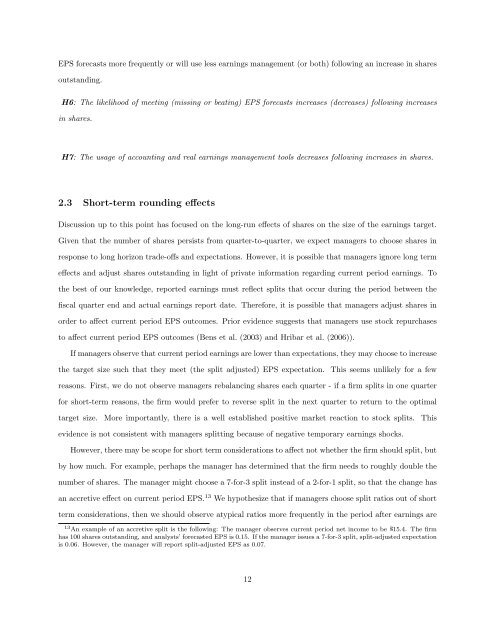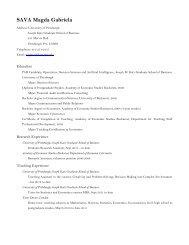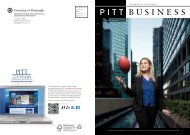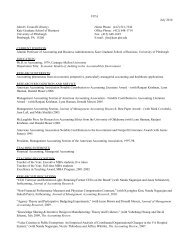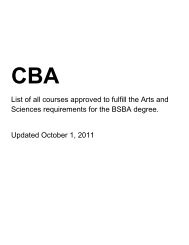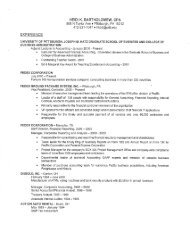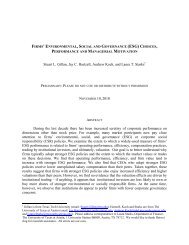Gaming the Float: How Managers Respond to EPS-based Incentives
Gaming the Float: How Managers Respond to EPS-based Incentives
Gaming the Float: How Managers Respond to EPS-based Incentives
You also want an ePaper? Increase the reach of your titles
YUMPU automatically turns print PDFs into web optimized ePapers that Google loves.
<strong>EPS</strong> forecasts more frequently or will use less earnings management (or both) following an increase in shares<br />
outstanding.<br />
H6: The likelihood of meeting (missing or beating) <strong>EPS</strong> forecasts increases (decreases) following increases<br />
in shares.<br />
H7: The usage of accounting and real earnings management <strong>to</strong>ols decreases following increases in shares.<br />
2.3 Short-term rounding effects<br />
Discussion up <strong>to</strong> this point has focused on <strong>the</strong> long-run effects of shares on <strong>the</strong> size of <strong>the</strong> earnings target.<br />
Given that <strong>the</strong> number of shares persists from quarter-<strong>to</strong>-quarter, we expect managers <strong>to</strong> choose shares in<br />
response <strong>to</strong> long horizon trade-offs and expectations. <strong>How</strong>ever, it is possible that managers ignore long term<br />
effects and adjust shares outstanding in light of private information regarding current period earnings. To<br />
<strong>the</strong> best of our knowledge, reported earnings must reflect splits that occur during <strong>the</strong> period between <strong>the</strong><br />
fiscal quarter end and actual earnings report date. Therefore, it is possible that managers adjust shares in<br />
order <strong>to</strong> affect current period <strong>EPS</strong> outcomes. Prior evidence suggests that managers use s<strong>to</strong>ck repurchases<br />
<strong>to</strong> affect current period <strong>EPS</strong> outcomes (Bens et al. (2003) and Hribar et al. (2006)).<br />
If managers observe that current period earnings are lower than expectations, <strong>the</strong>y may choose <strong>to</strong> increase<br />
<strong>the</strong> target size such that <strong>the</strong>y meet (<strong>the</strong> split adjusted) <strong>EPS</strong> expectation. This seems unlikely for a few<br />
reasons. First, we do not observe managers rebalancing shares each quarter - if a firm splits in one quarter<br />
for short-term reasons, <strong>the</strong> firm would prefer <strong>to</strong> reverse split in <strong>the</strong> next quarter <strong>to</strong> return <strong>to</strong> <strong>the</strong> optimal<br />
target size. More importantly, <strong>the</strong>re is a well established positive market reaction <strong>to</strong> s<strong>to</strong>ck splits. This<br />
evidence is not consistent with managers splitting because of negative temporary earnings shocks.<br />
<strong>How</strong>ever, <strong>the</strong>re may be scope for short term considerations <strong>to</strong> affect not whe<strong>the</strong>r <strong>the</strong> firm should split, but<br />
by how much. For example, perhaps <strong>the</strong> manager has determined that <strong>the</strong> firm needs <strong>to</strong> roughly double <strong>the</strong><br />
number of shares. The manager might choose a 7-for-3 split instead of a 2-for-1 split, so that <strong>the</strong> change has<br />
an accretive effect on current period <strong>EPS</strong>. 13 We hypo<strong>the</strong>size that if managers choose split ratios out of short<br />
term considerations, <strong>the</strong>n we should observe atypical ratios more frequently in <strong>the</strong> period after earnings are<br />
13 An example of an accretive split is <strong>the</strong> following: The manager observes current period net income <strong>to</strong> be $15.4. The firm<br />
has 100 shares outstanding, and analysts’ forecasted <strong>EPS</strong> is 0.15. If <strong>the</strong> manager issues a 7-for-3 split, split-adjusted expectation<br />
is 0.06. <strong>How</strong>ever, <strong>the</strong> manager will report split-adjusted <strong>EPS</strong> as 0.07.<br />
12


